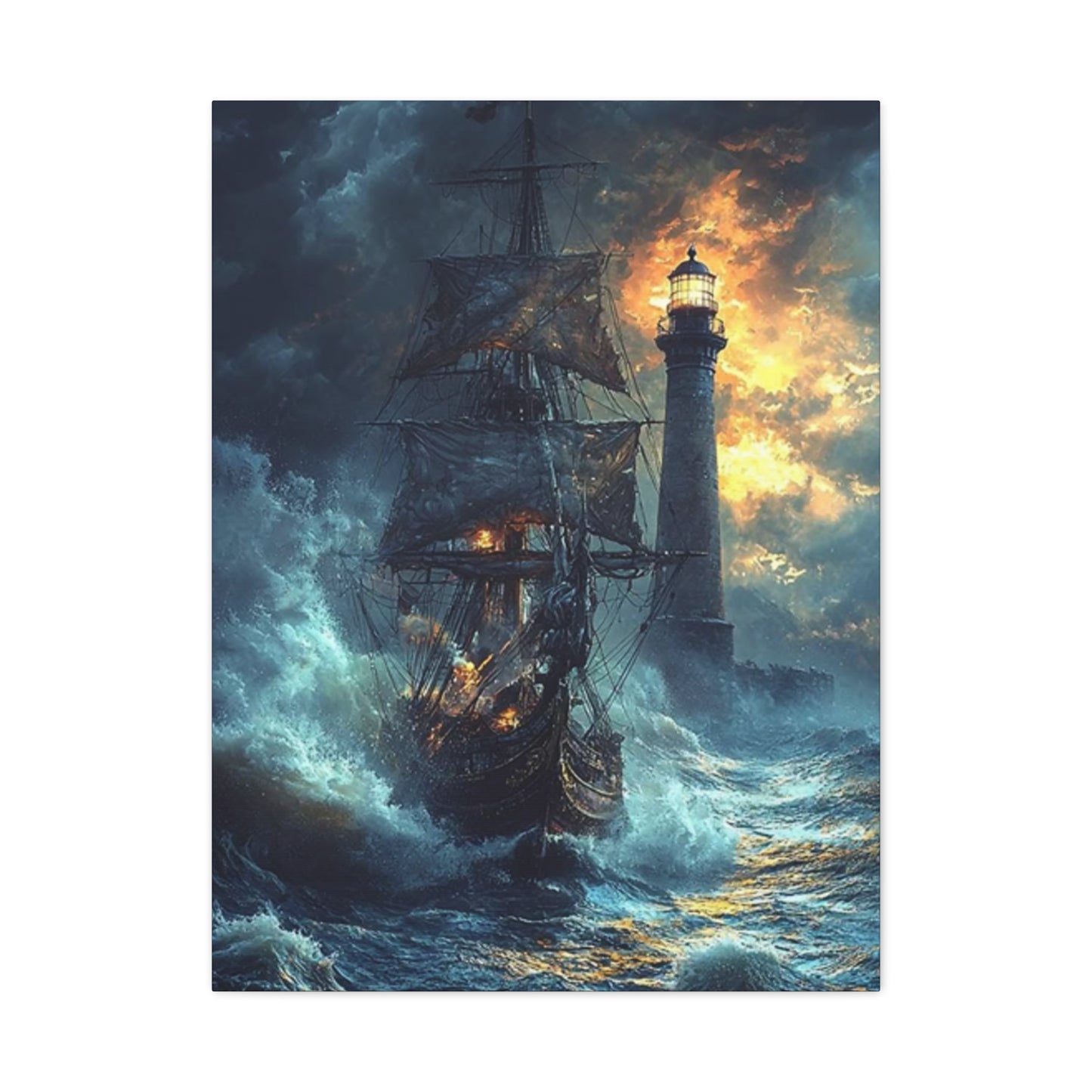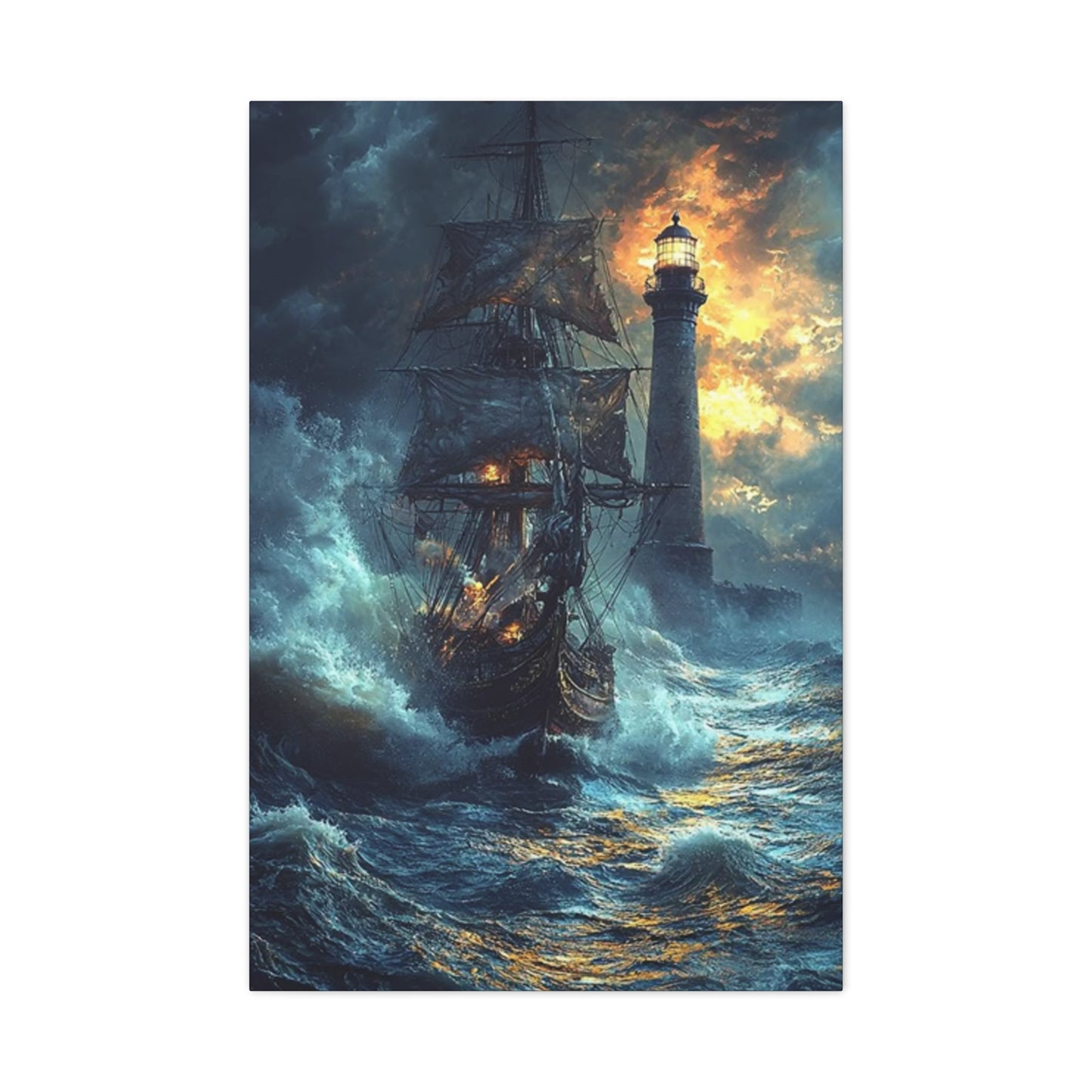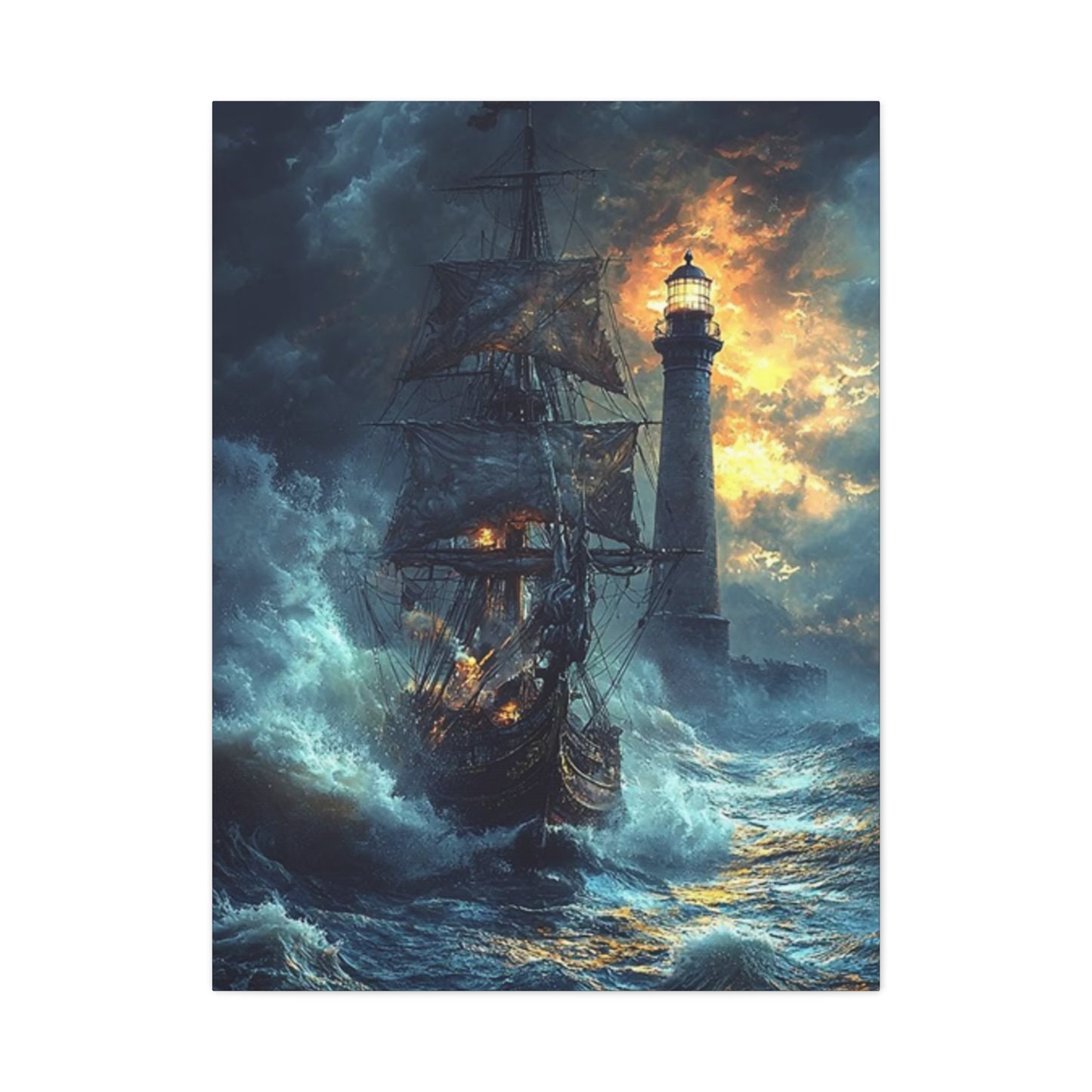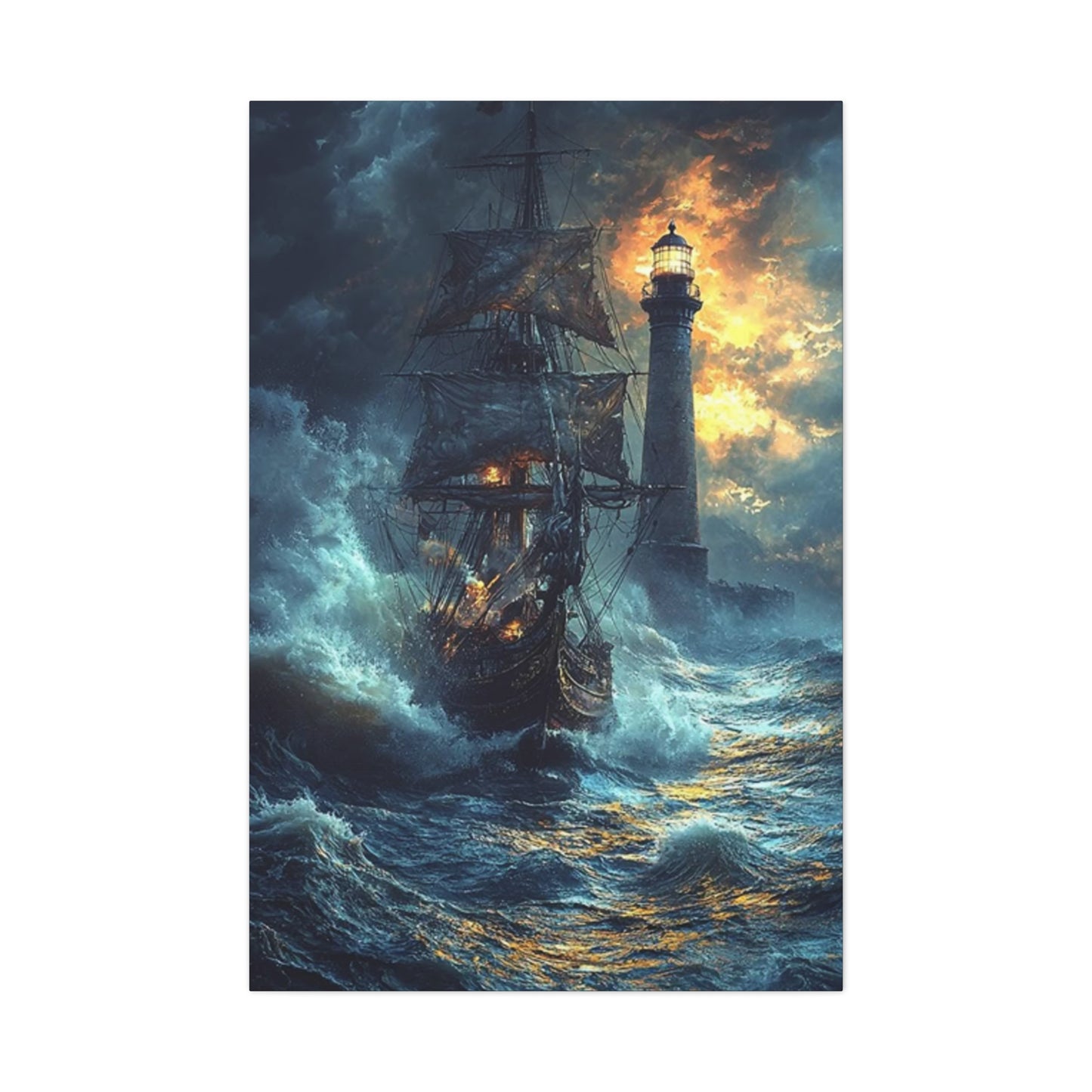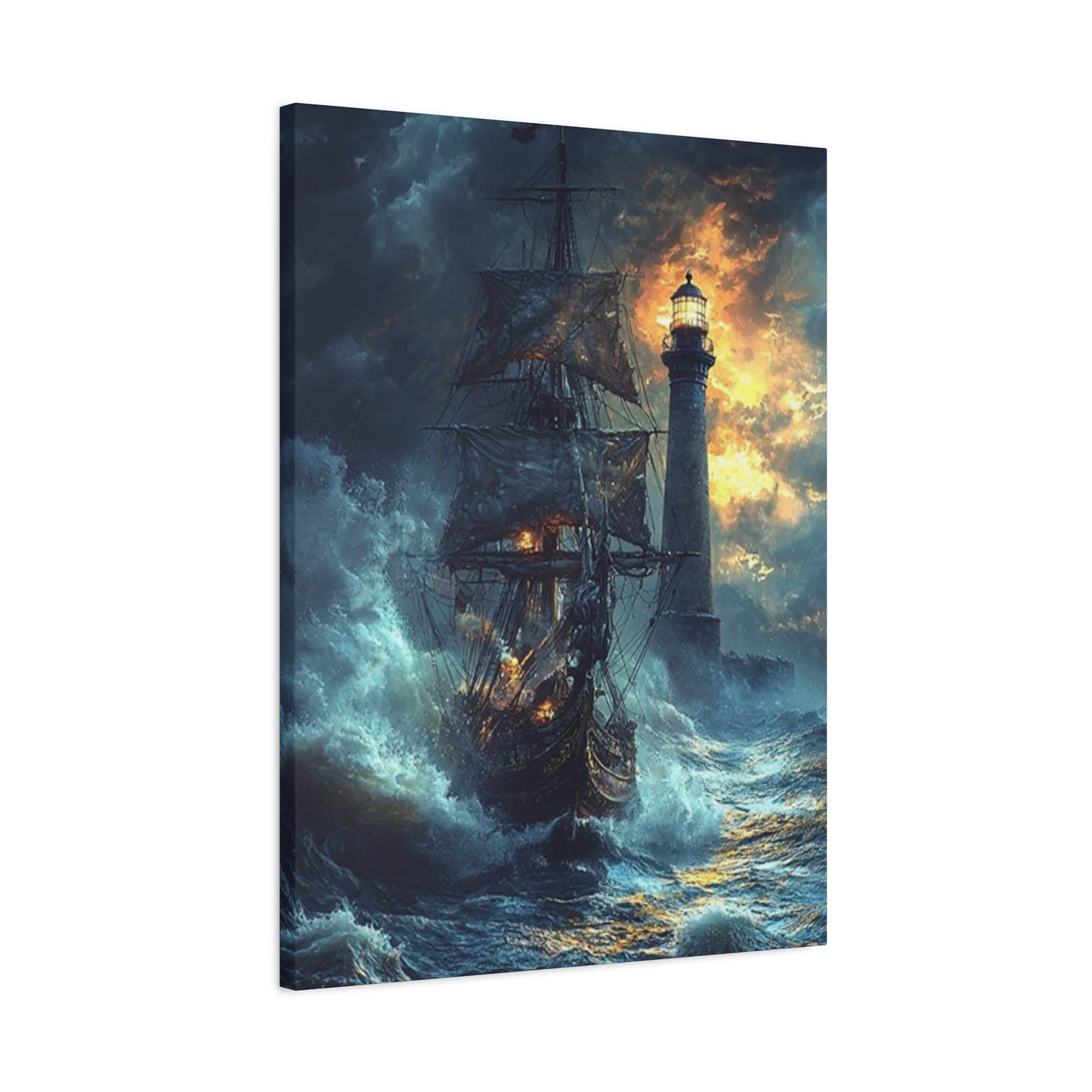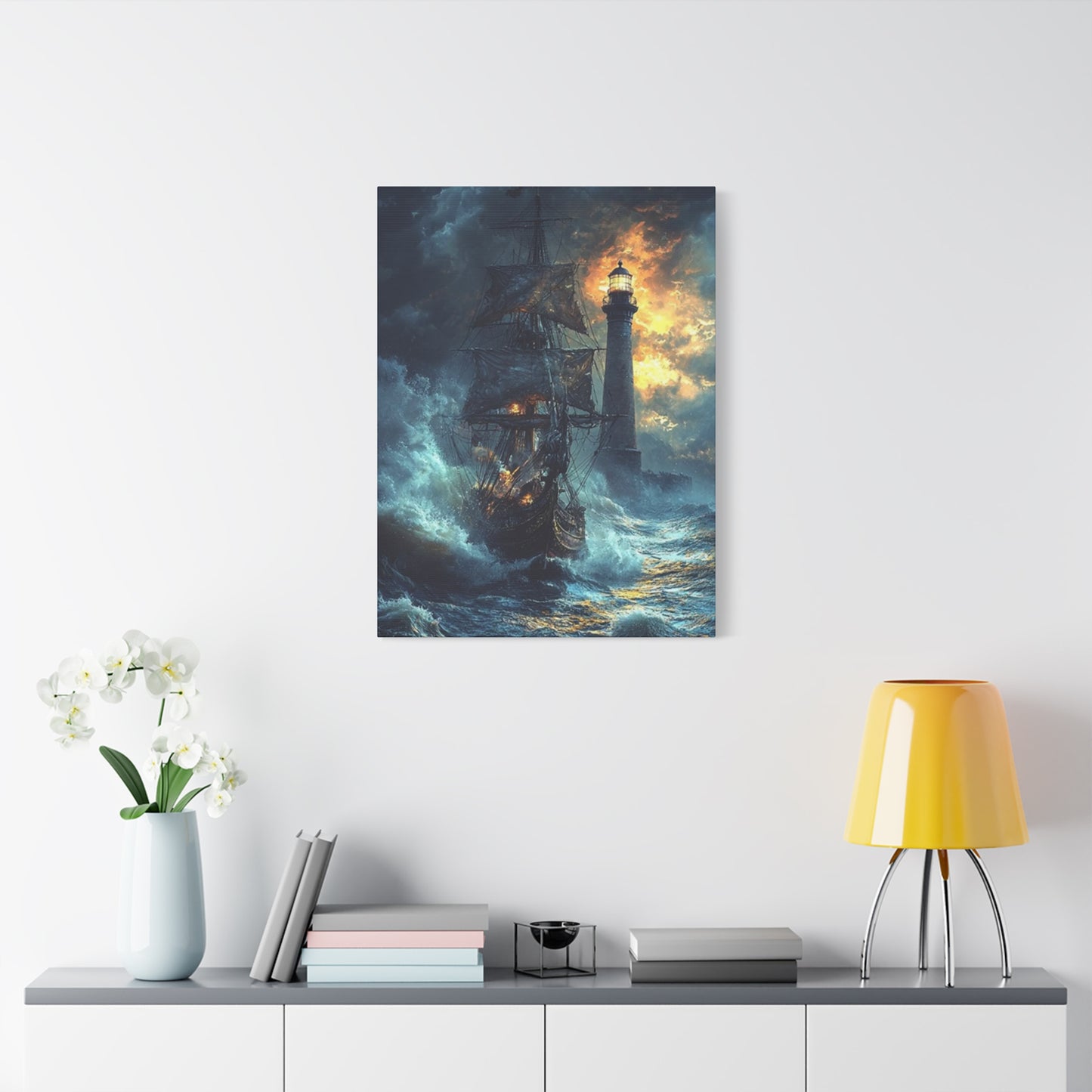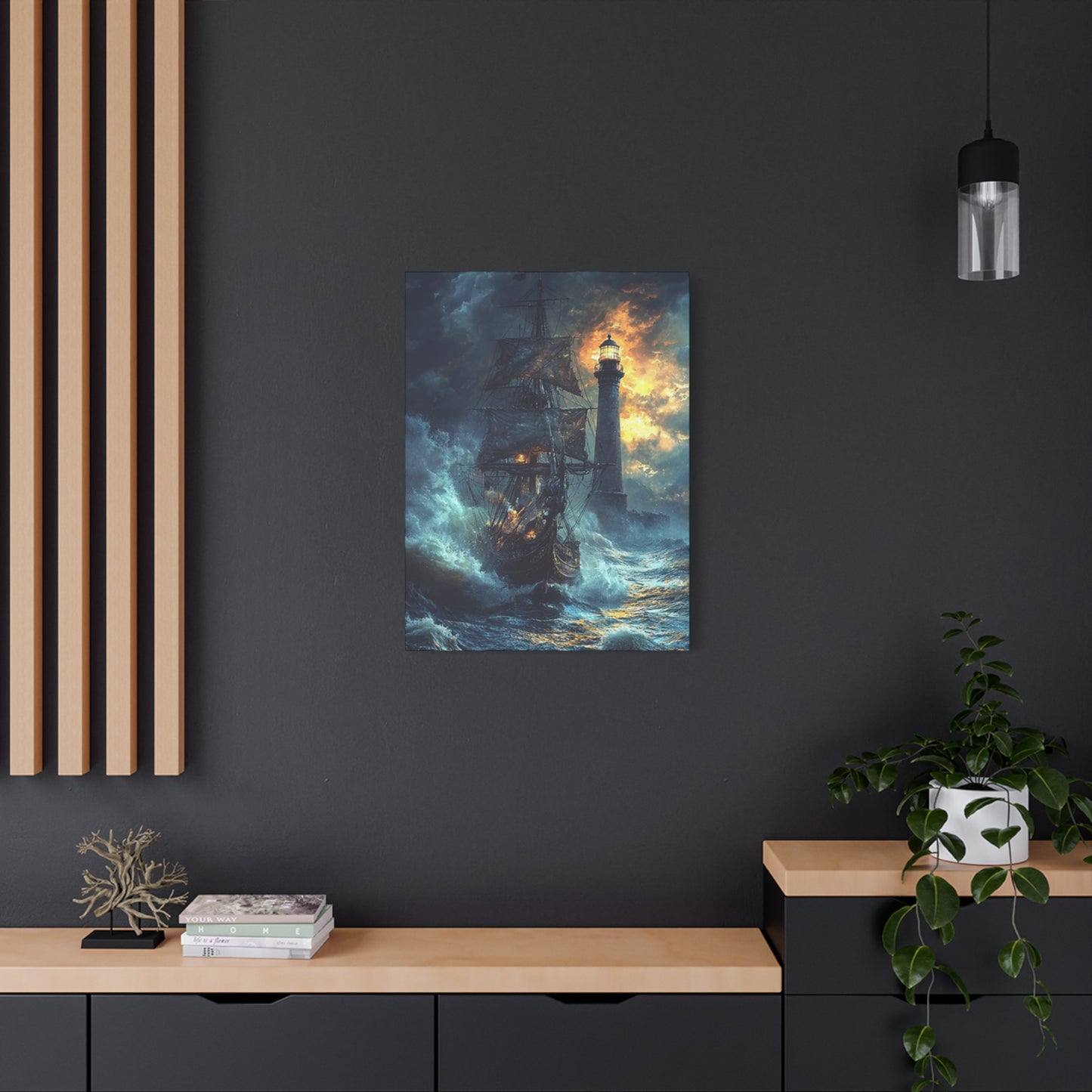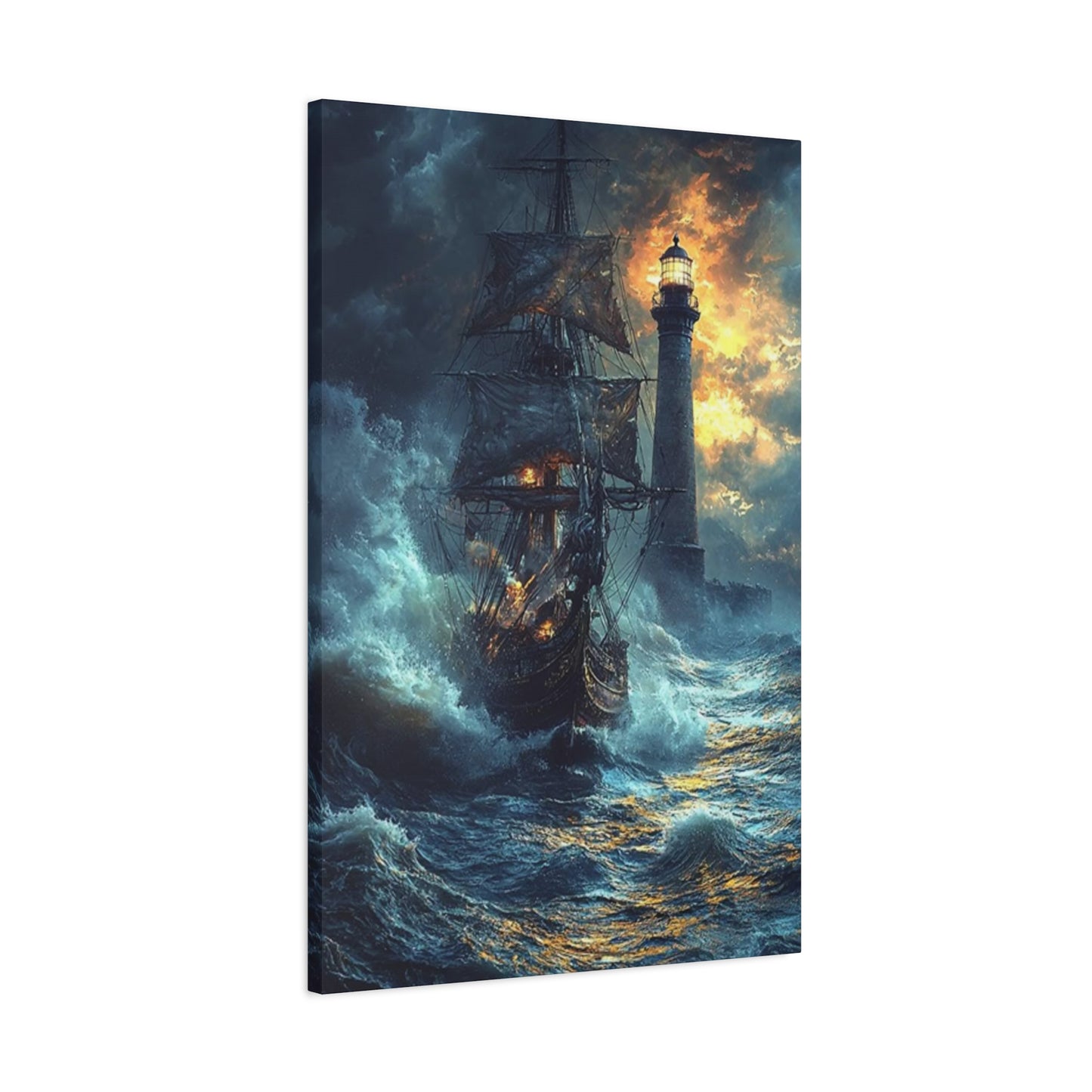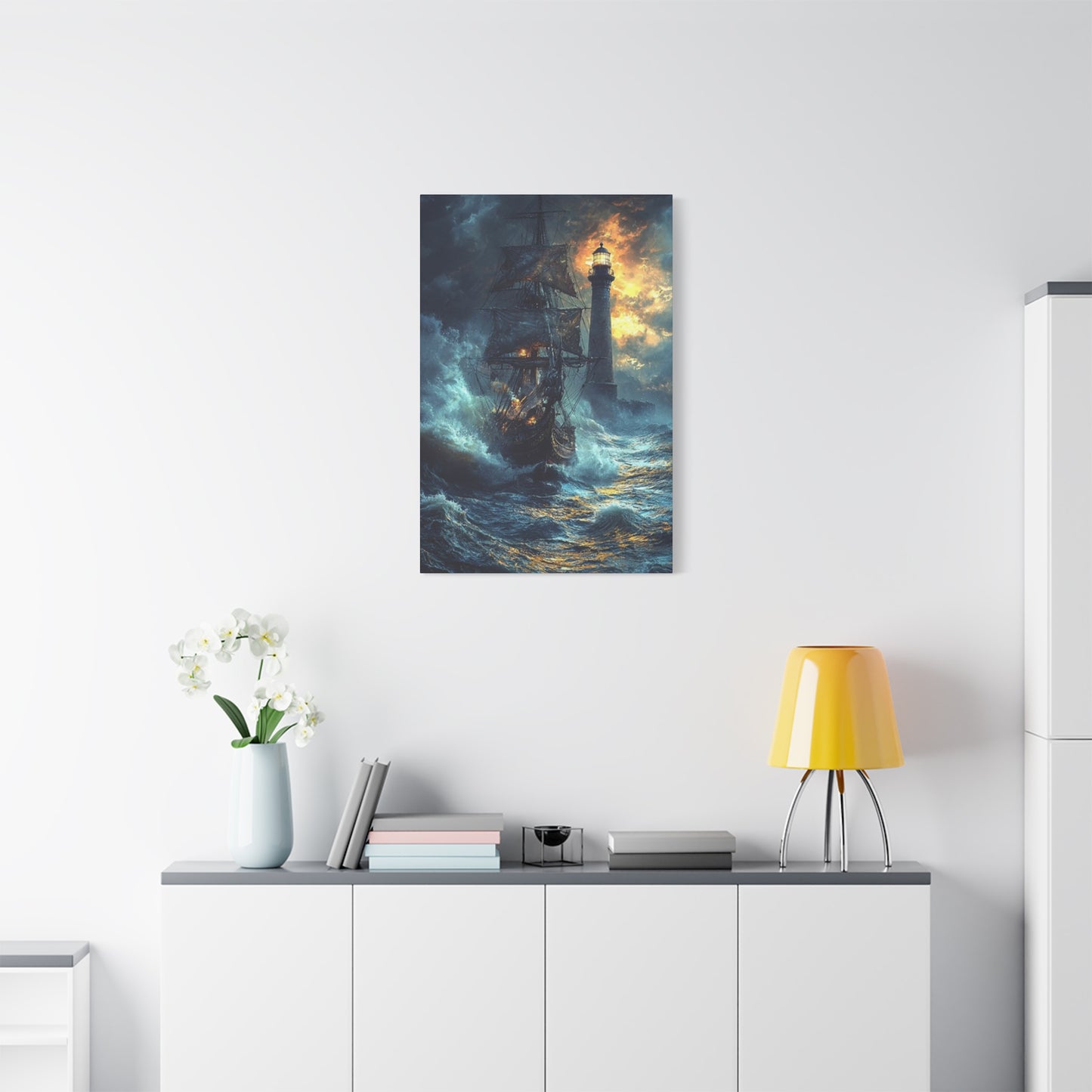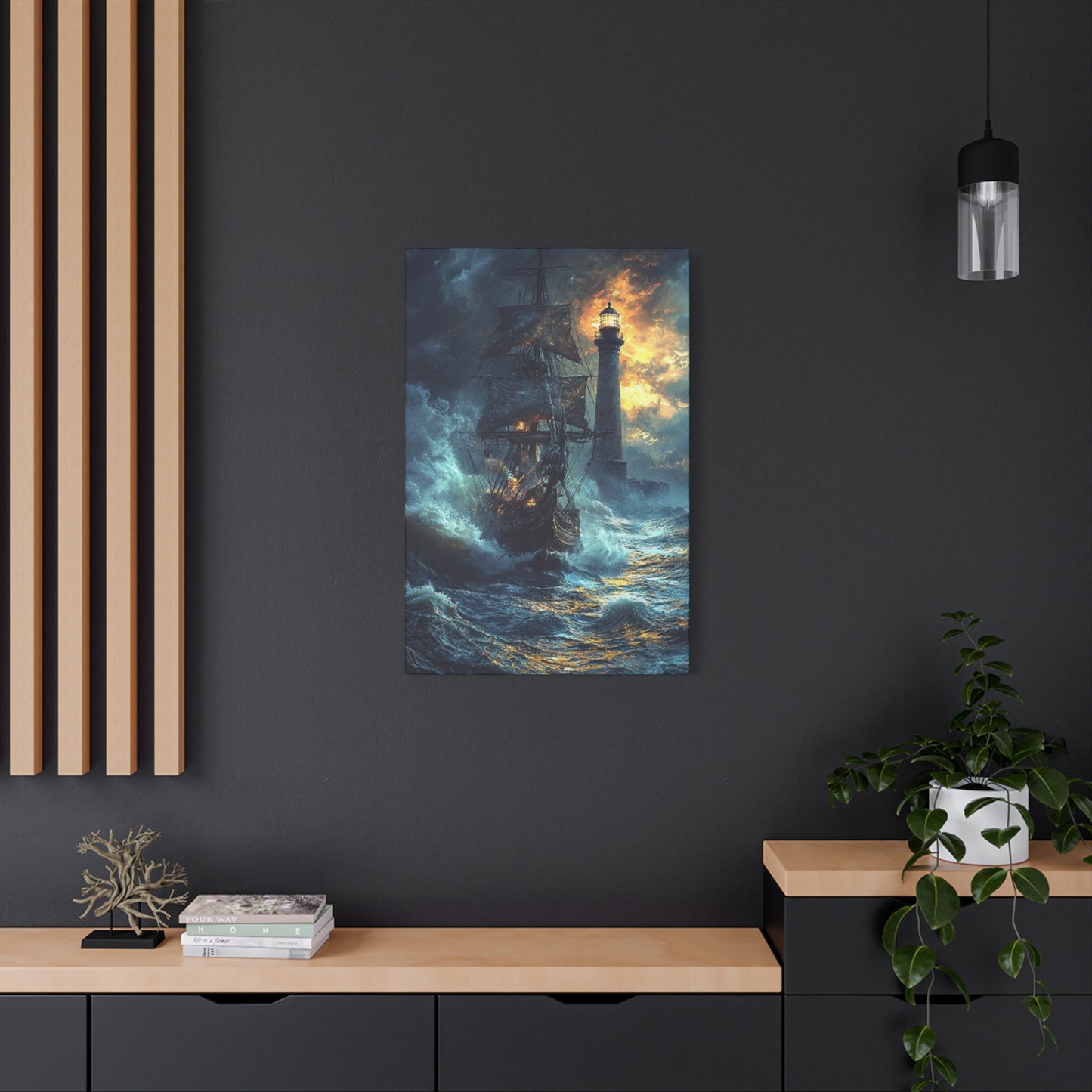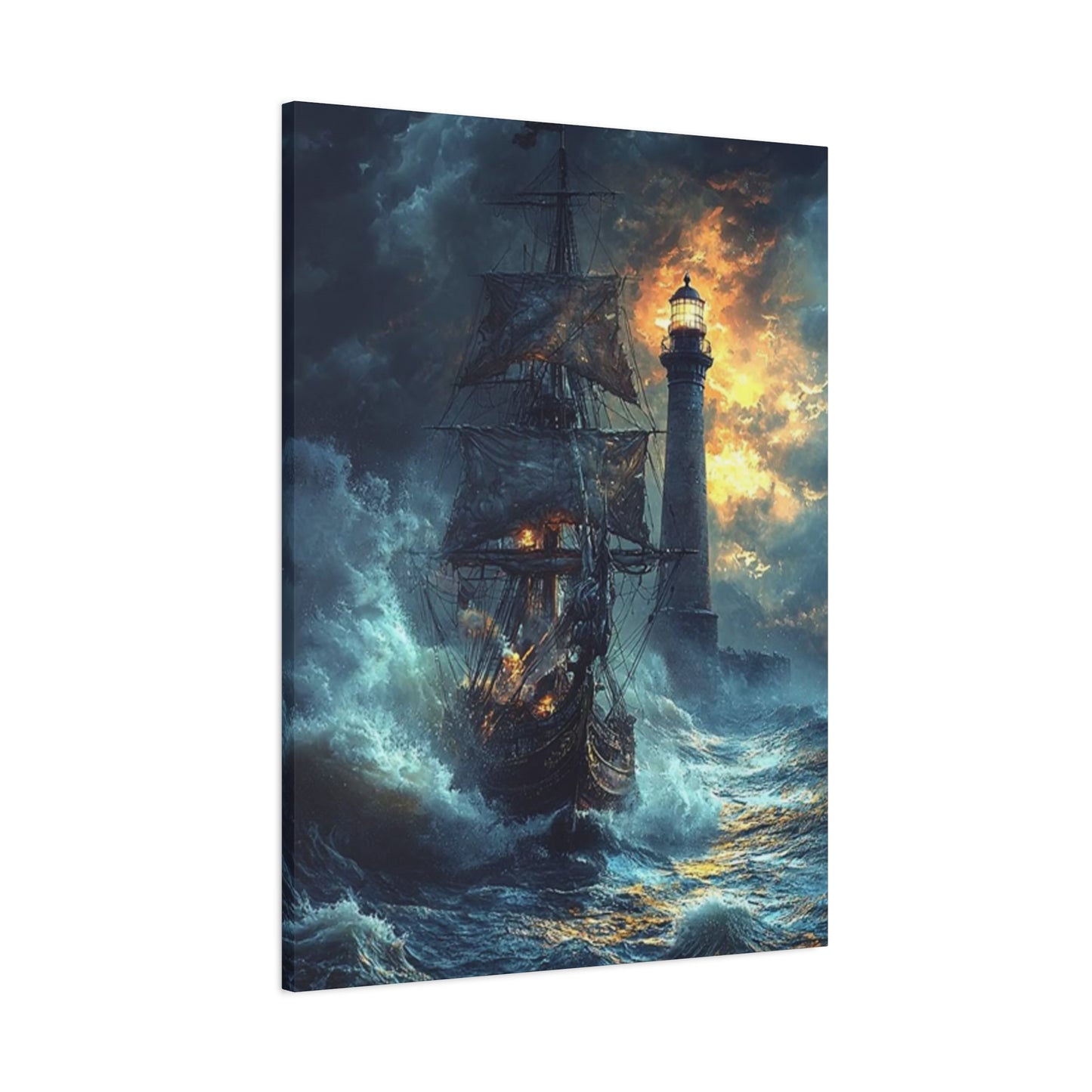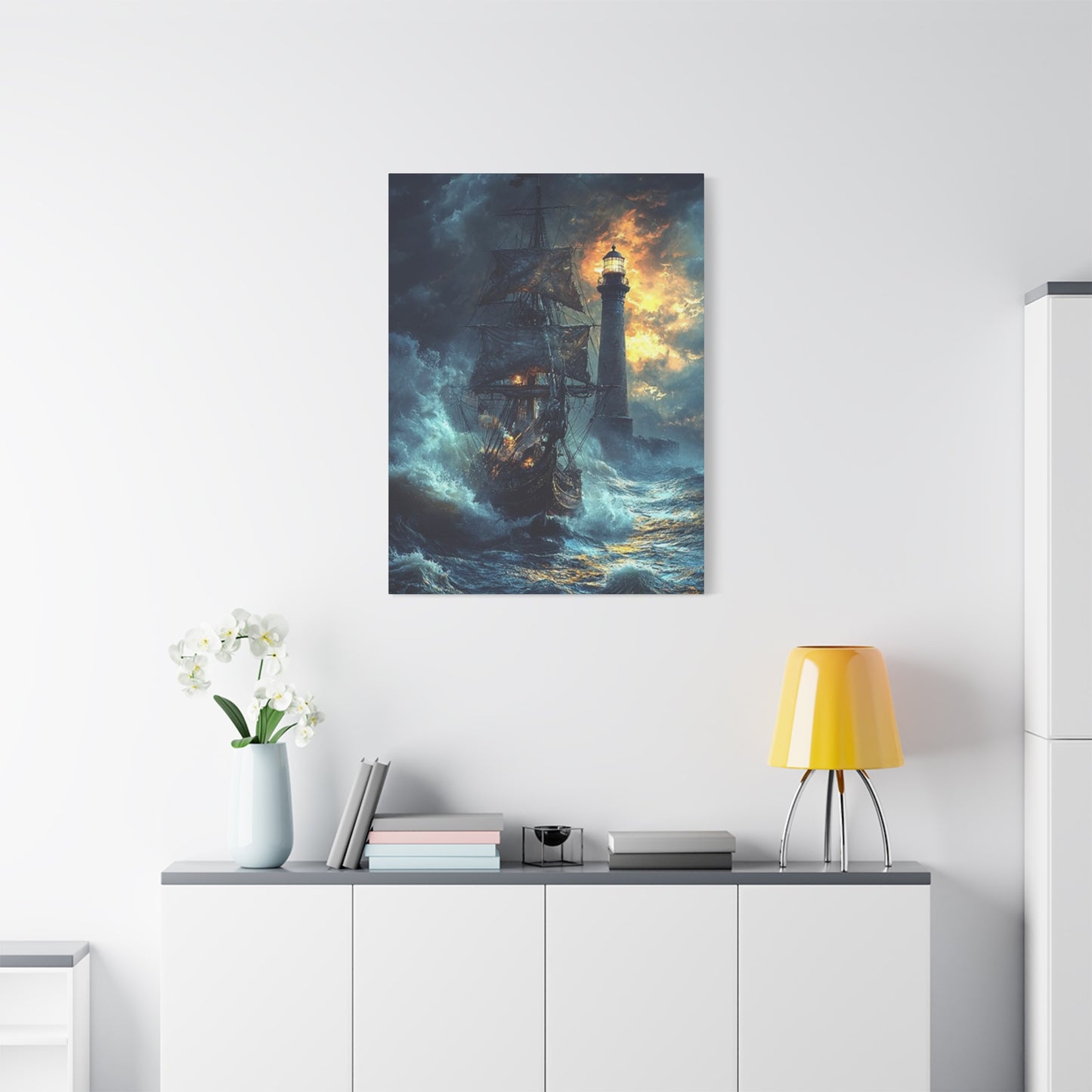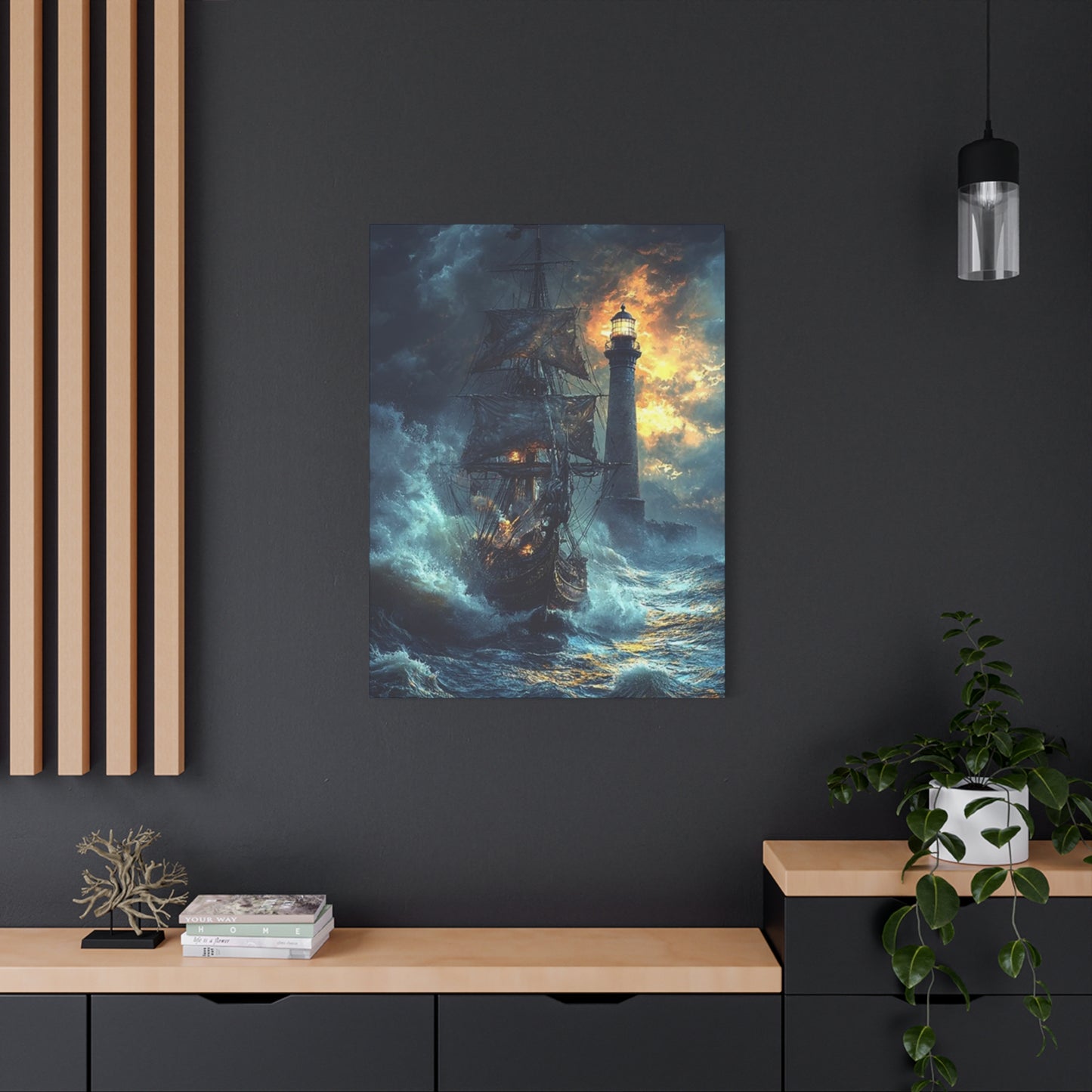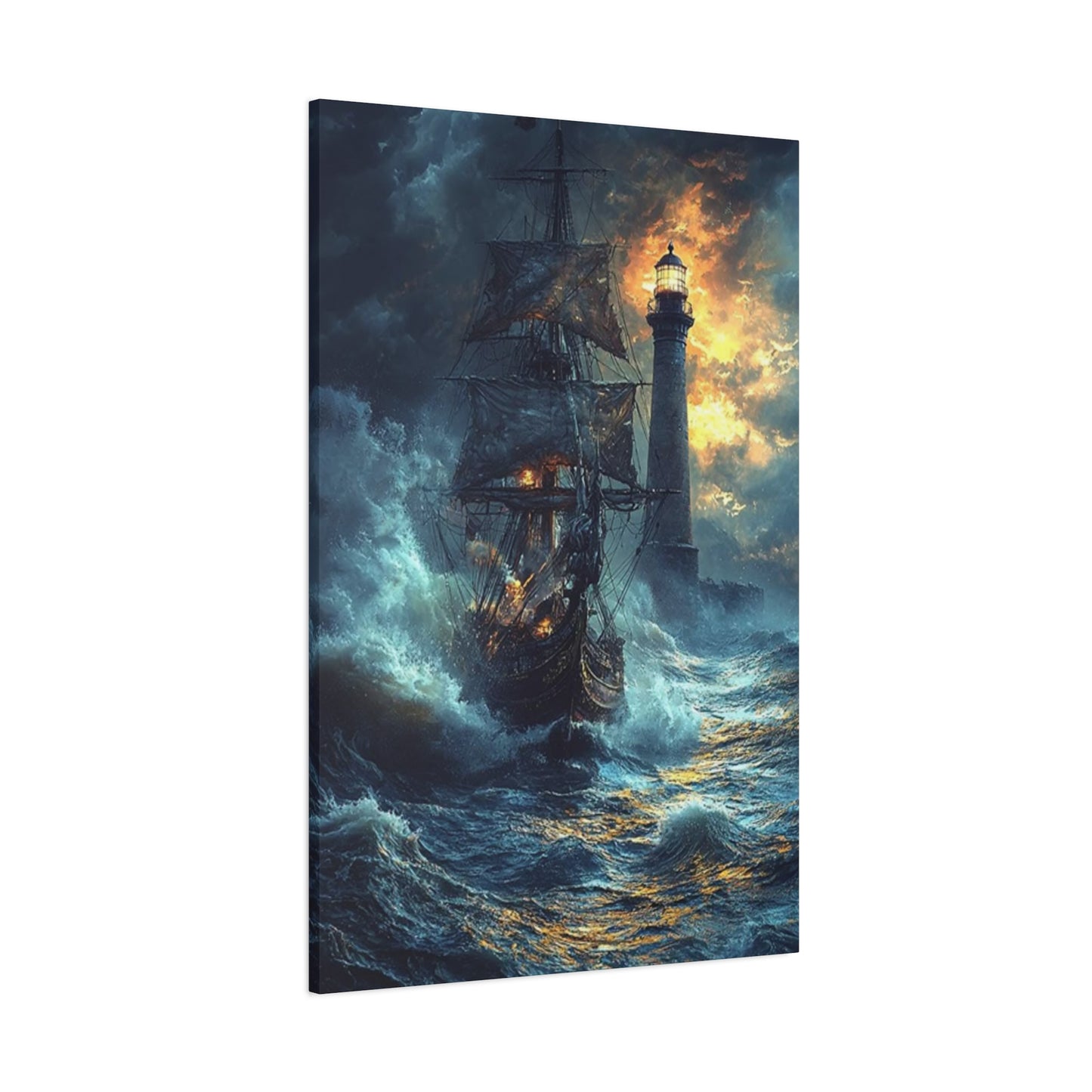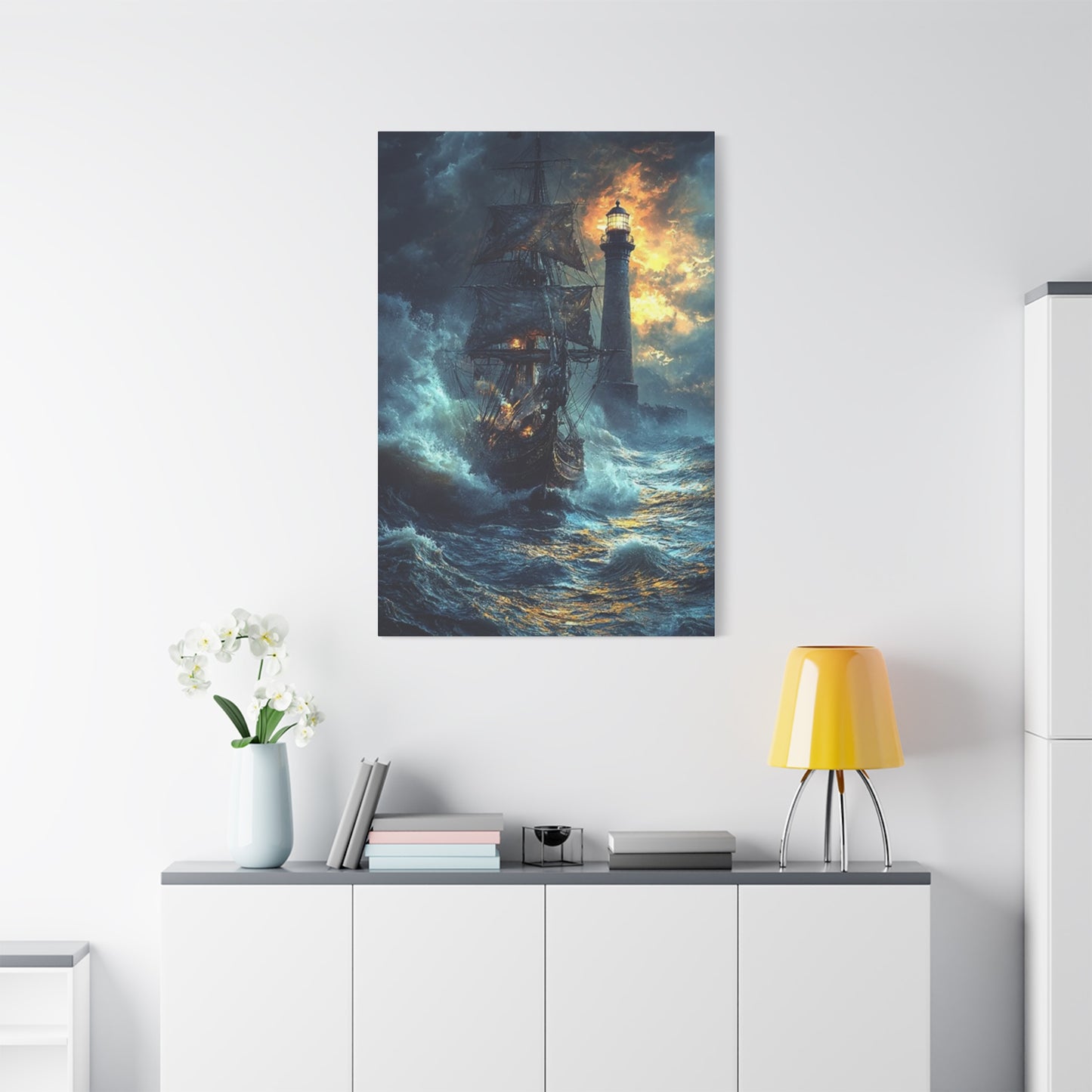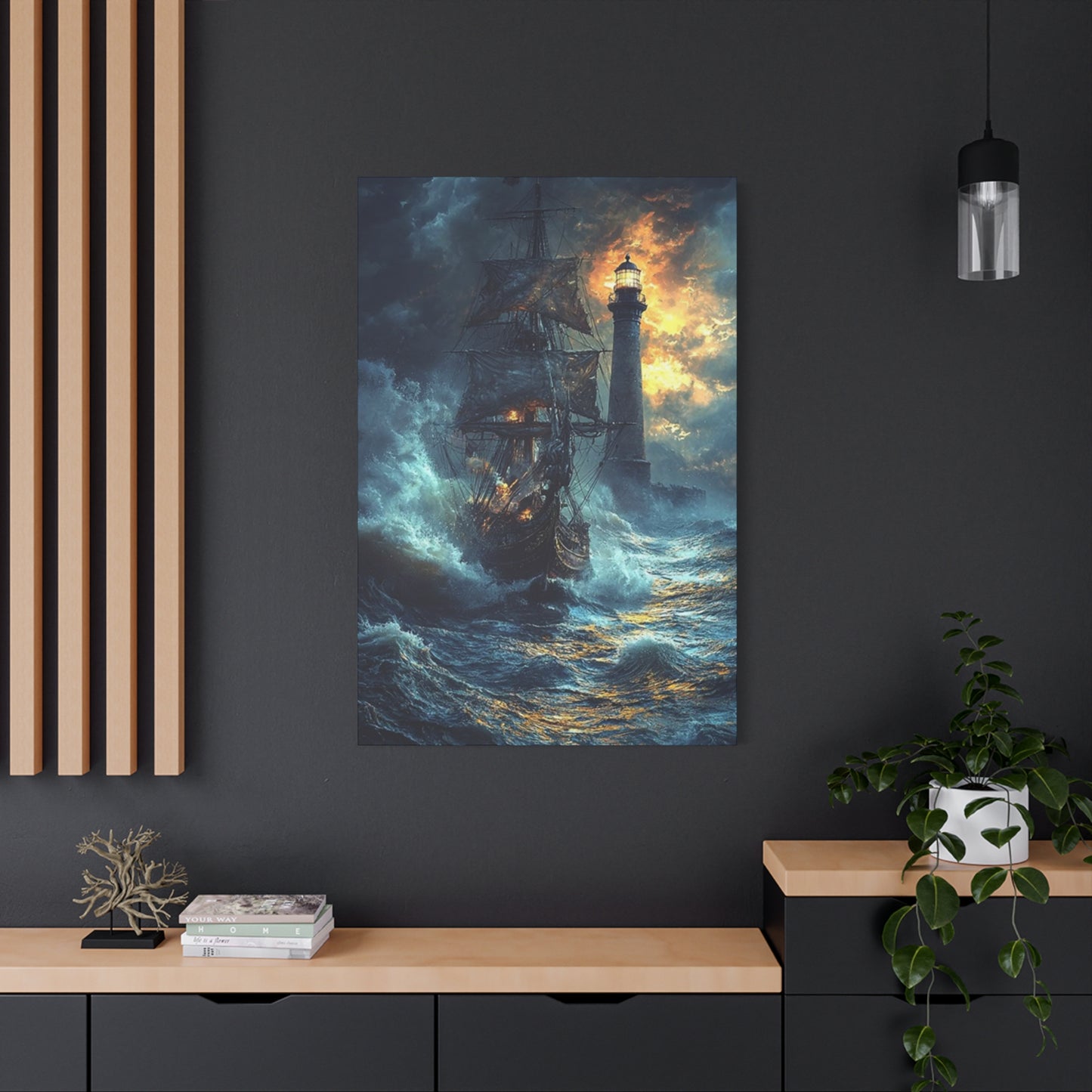The Art of Light: Contrasting Darkness and Illumination in Lighthouse Wall Art
The allure of maritime themes has captivated homeowners for centuries, and nighttime nautical wall art represents one of the most enchanting ways to incorporate oceanic beauty into residential environments. These artistic pieces combine the mystique of darkened seas with the romance of maritime adventures, creating atmospheres that evoke tranquility, adventure, and timeless elegance. Whether you're drawn to the gentle glow of lighthouse beacons cutting through midnight fog or the silhouette of sailing vessels against star-studded skies, nocturnal ocean artwork offers endless possibilities for transforming living environments.
The magnetic appeal of nighttime maritime scenes stems from their ability to capture moments of profound serenity and mystery. Unlike their daylight counterparts, these artistic representations embrace shadows, subtle lighting, and atmospheric depth that speaks to our innate connection with the ocean's nocturnal moods. From dramatic lighthouse scenes illuminating rocky coastlines to peaceful moonlit harbors where sailing ships rest at anchor, these artworks transport viewers to coastal realms where time moves at the gentle rhythm of tides.
Contemporary artists and traditional painters alike have long recognized the emotional power inherent in nighttime oceanic imagery. The interplay between darkness and selective illumination creates visual narratives that resonate with viewers on multiple levels, combining aesthetic beauty with deeper psychological connections to maritime heritage and oceanic environments. These pieces serve not merely as decorative elements but as windows to imaginary voyages and coastal escapes.
Lighthouse Glow: Sea at Night Masterpieces
Lighthouse imagery represents perhaps the most iconic element in nighttime nautical wall art, serving as beacons of hope and guidance that have inspired artists for generations. These towering structures, silhouetted against dramatic skies or casting brilliant beams across churning waters, embody the eternal struggle between human ingenuity and oceanic forces. The artistic representation of lighthouse glow creates focal points that draw viewers into contemplative states, evoking feelings of safety, guidance, and maritime romance.
Artists approach lighthouse scenes with varied techniques, from impressionistic renderings that capture the ethereal quality of light dispersing through coastal fog to photorealistic depictions that showcase architectural details of these maritime monuments. The interplay between artificial lighthouse illumination and natural moonlight creates layered lighting effects that add depth and visual interest to any room. These compositions often feature dramatic contrasts between the warm golden glow emanating from lighthouse windows and the cool blues and purples of nighttime ocean scenes.
The emotional resonance of lighthouse artwork extends beyond mere aesthetic appreciation. These images tap into archetypal symbols of guidance, safety, and homecoming that speak to fundamental human experiences. Whether displayed in living rooms, bedrooms, or hallways, lighthouse glow artwork creates atmospheric anchors that establish moods of contemplation and tranquility. The repetitive beam patterns suggested by many lighthouse artworks also introduce elements of rhythm and movement that keep these static images visually engaging over time.
Modern interpretations of lighthouse themes incorporate contemporary artistic techniques while maintaining classical maritime aesthetics. Digital artists create stunning representations that blend photographic realism with painterly effects, while traditional oil painters continue exploring these timeless subjects through established techniques. The versatility of lighthouse imagery allows for adaptation across various artistic styles, from minimalist silhouettes to elaborate seascapes filled with intricate details of coastal geography and maritime architecture.
Sailing Ships Under Moonlight Elegance
The romantic imagery of sailing vessels navigating by moonlight captures the adventurous spirit that has driven maritime exploration throughout human history. These artistic representations transform ordinary walls into portals for imaginative voyages, where majestic ships with billowing sails traverse silvery waters beneath celestial illumination. The interplay between ship silhouettes and lunar reflections creates compositions that balance movement with serenity, adventure with peace.
Moonlit sailing scenes offer artists opportunities to explore complex lighting relationships that challenge technical skills while producing emotionally evocative results. The reflective quality of water surfaces multiplies light sources, creating shimmering pathways that lead the eye through compositional elements while maintaining overall harmony. These lighting effects transform simple maritime scenes into complex visual experiences that reward extended viewing with new discovered details and subtle atmospheric effects.
Historical sailing vessels, from elegant clipper ships to sturdy merchant vessels, provide rich subject matter for artists exploring nighttime oceanic themes. The intricate rigging, distinctive sail configurations, and varied hull designs of different ship types offer endless possibilities for creating unique artistic interpretations. Whether depicted as solitary vessels on vast oceanic expanses or as fleets engaged in nocturnal voyages, these maritime subjects embody human ambition and the timeless appeal of oceanic exploration.
Contemporary artists working with sailing ship imagery often incorporate modern understanding of oceanography and astronomy to create scientifically plausible yet artistically enhanced representations. The positioning of moon phases, star patterns, and tidal conditions reflects careful research that adds authenticity to these imaginative compositions. This attention to maritime detail enhances the believability of these artistic worlds while maintaining the romantic idealization that makes them appealing as residential artwork.
The scale relationships between ships and oceanic environments in these artworks serve important compositional functions, creating sense of both human achievement and natural grandeur. Small vessels dwarfed by vast seascapes emphasize the courage required for oceanic exploration, while larger ships depicted in intimate detail celebrate human craftsmanship and maritime technology. These varying approaches allow collectors to select pieces that reflect their personal connections to maritime themes and preferred emotional tones.
Coastal Nights: Lighthouse Art Collections
Building comprehensive collections of coastal lighthouse artwork requires understanding the diverse artistic approaches that different creators bring to these beloved maritime subjects. Coastal night scenes featuring lighthouse elements range from abstract interpretations that emphasize atmospheric effects to detailed architectural studies that celebrate the engineering achievements represented by these coastal guardians. The variety within this artistic niche ensures that collectors can develop personalized collections that reflect individual tastes while maintaining thematic coherence.
Regional lighthouse designs provide rich source material for artists exploring coastal night themes. The distinctive architectural styles found along different coastlines, from the red brick towers of New England to the white-washed structures of Mediterranean shores, offer opportunities for creating location-specific artwork that celebrates particular maritime heritage. These regional variations allow collectors to focus on specific geographic areas that hold personal significance while building comprehensive artistic representations of coastal lighthouse traditions.
The seasonal aspects of coastal lighthouse scenes add temporal dimensions to these artistic collections. Winter lighthouse scenes featuring storm-lashed towers battling against fierce winds create dramatically different moods than summer evening scenes showing gentle beams sweeping across calm waters. Artists capture these seasonal variations through careful attention to meteorological details, vegetation patterns, and lighting conditions that reflect specific times of year and weather patterns characteristic of different coastal regions.
Artistic techniques employed in lighthouse artwork span the full spectrum of available media, from traditional oil paintings that capture rich textural details to contemporary digital creations that explore photographic realism enhanced with painterly effects. Watercolor lighthouse scenes often emphasize atmospheric qualities and fluid transitions between sea and sky, while acrylic paintings allow for bold color contrasts and precise architectural details. The diversity of available techniques ensures that collectors can find lighthouse artwork compatible with existing decor styles and personal aesthetic preferences.
The symbolic significance of lighthouse imagery makes these artworks particularly suitable for specific residential locations. Entryway displays featuring lighthouse art create welcoming atmospheres that suggest guidance and hospitality, while bedroom lighthouse scenes promote feelings of security and peaceful contemplation. Study and office environments benefit from lighthouse imagery that evokes themes of guidance, perseverance, and steady reliability in the face of challenging conditions.
Mystery of Sea and Light Atmospheric Effects
The mysterious qualities inherent in nighttime oceanic scenes create opportunities for artists to explore atmospheric effects that blur the boundaries between reality and imagination. These ethereal compositions combine natural phenomena like moonbeams, fog banks, and bioluminescent waters with artistic interpretation to produce images that evoke wonder and contemplation. The interplay between revealed and concealed elements in these mysterious seascapes invites viewers to participate in ongoing visual discoveries that unfold through extended observation.
Fog and mist effects in nighttime oceanic artwork serve both aesthetic and narrative functions, creating depth through atmospheric perspective while adding elements of mystery that stimulate imagination. Artists achieve these effects through various techniques, from soft blending methods that create gradual transitions to more dramatic approaches that emphasize the contrast between clear and obscured areas. The selective visibility created by atmospheric effects allows artists to guide viewer attention while maintaining overall compositional mystery.
Bioluminescent phenomena provide unique opportunities for creating nighttime oceanic artwork that incorporates natural light sources beyond conventional moonlight and artificial illumination. The ethereal glow produced by phosphorescent plankton, the trails left by swimming marine life, and other naturally occurring light phenomena add magical qualities to realistic oceanic scenes. These effects transform ordinary seascapes into extraordinary visual experiences that celebrate the hidden wonders of marine environments.
The psychological impact of mysterious oceanic imagery relates to fundamental human responses to the unknown aspects of marine environments. The ocean's vast depths and hidden creatures have inspired human imagination throughout history, creating cultural associations that artists can tap into when creating atmospheric nighttime seascapes. These mysterious qualities make oceanic artwork particularly effective for creating contemplative environments that encourage introspection and imaginative engagement.
Color palette choices play crucial roles in establishing mysterious atmospheric effects in nighttime oceanic artwork. Cool blues and purples dominate many of these compositions, creating sense of depth and coolness associated with nighttime conditions. Strategic use of warmer accent colors, whether from moonlight, lighthouse beams, or other light sources, creates focal points that prevent these predominantly cool compositions from becoming visually monotonous while maintaining overall atmospheric coherence.
Ocean Calm: Night Wall Art Serenity
Serene nighttime oceanic scenes offer viewers opportunities to experience tranquility and peace through carefully composed artistic representations of calm maritime conditions. These restful compositions emphasize horizontal elements, gentle curves, and subtle transitions that promote relaxation and contemplative states. The absence of dramatic weather conditions or turbulent waters in these peaceful scenes creates environments that support meditation and stress reduction.
The therapeutic qualities of calm oceanic imagery have been recognized by healthcare professionals and environmental psychologists who study the effects of natural imagery on human wellbeing. Gentle lapping waves, moonlight reflections on still waters, and the soft silhouettes of distant horizons create visual environments that can help reduce anxiety and promote restful states. These beneficial effects make serene nighttime oceanic artwork particularly valuable for bedrooms, meditation areas, and other locations where relaxation is prioritized.
Compositional techniques used to create calm oceanic scenes emphasize balance, repetition, and gentle movement that suggests natural rhythms without creating visual agitation. Horizontal lines dominate these compositions, reflecting the natural tendency of water surfaces to establish level planes that create inherent stability. The repetitive patterns suggested by gentle wave action provide rhythmic elements that can have almost hypnotic effects on viewers seeking peaceful visual experiences.
Color harmonies in serene nighttime oceanic artwork typically employ limited palettes that avoid jarring contrasts or overly saturated hues. Subtle variations within narrow color ranges create sophisticated visual effects that reward careful observation while maintaining overall restfulness. The monochromatic or analogous color schemes commonly used in these peaceful compositions create sense of unity and coherence that supports their calming functions.
The scale relationships depicted in calm oceanic artwork often emphasize the vastness and continuity of marine environments while avoiding elements that might create feelings of isolation or vulnerability. Gentle coastal features, distant sailing vessels, and other human-scale elements provide reference points that help viewers feel connected to these peaceful oceanic environments rather than overwhelmed by their immensity. These carefully balanced compositions create sense of being peacefully embraced by oceanic serenity rather than lost in vast watery expanses.
Guiding Light by the Sea Navigation Themes
Navigation themes in nighttime nautical wall art celebrate the long history of maritime wayfinding and the crucial role that coastal light sources have played in safe oceanic travel. These artistic interpretations combine historical accuracy with romantic idealization to create images that honor maritime traditions while appealing to contemporary aesthetic sensibilities. The symbolism of guidance and safe passage embedded in navigation imagery makes these artworks particularly meaningful for residential applications.
Traditional navigation methods provide rich source material for artists exploring maritime themes, from celestial navigation techniques that rely on star patterns to coastal piloting methods that use lighthouse beacons and other fixed reference points. Artistic representations of these navigation approaches often incorporate multiple light sources and reference points that create complex compositional relationships while maintaining clear focal hierarchies. These technically informed artworks appeal to maritime enthusiasts who appreciate authentic details while remaining accessible to general audiences.
The evolution of navigation technology offers opportunities for creating artwork that bridges historical and contemporary maritime practices. Traditional sailing vessels equipped with modern navigation equipment, historic lighthouses enhanced with contemporary lighting systems, and other technological hybrids create interesting visual juxtapositions that reflect the ongoing development of maritime safety systems. These evolutionary themes add narrative depth to navigation-focused artwork while celebrating both tradition and progress.
Symbolic interpretations of navigation themes extend beyond literal maritime applications to encompass broader metaphorical meanings related to guidance, decision-making, and life direction. The lighthouse beacon that guides ships safely to harbor becomes a symbol for wisdom and reliable counsel, while the compass rose represents the importance of maintaining clear direction through life's uncertainties. These deeper symbolic meanings make navigation-themed artwork suitable for offices, studies, and other environments where decision-making and leadership are important activities.
International variations in lighthouse design and navigation practices provide opportunities for creating culturally diverse collections of navigation-themed artwork. The distinctive architectural styles, lighting patterns, and coastal configurations found in different maritime regions reflect local conditions and cultural preferences that add educational value to these artistic collections. Collectors interested in specific geographic regions or cultural traditions can focus their acquisitions while maintaining thematic coherence around navigation subjects.
Ships Sailing in Dark Waters Adventure Imagery
The dramatic imagery of ships navigating through dark waters captures the essence of maritime adventure and the courage required for oceanic exploration. These powerful compositions emphasize the relationship between human ambition and natural forces, creating artwork that celebrates both the achievements of maritime technology and the awesome power of oceanic environments. The contrast between illuminated vessels and surrounding darkness creates visual drama that makes these artworks effective focal points in residential settings.
Historical maritime adventures provide rich narrative content for artists creating dark water sailing scenes. Famous voyages of exploration, legendary sea battles, and merchant expeditions to distant ports offer specific historical contexts that add educational value to purely aesthetic considerations. Artists can draw upon documented historical details to create authentic representations while maintaining artistic license to enhance dramatic effects and compositional strength.
The technical challenges of depicting ships in low-light conditions require careful attention to reflective surfaces, artificial lighting sources, and atmospheric effects that maintain visual clarity while preserving mysterious and dramatic qualities. Ship lights, including navigation lamps, cabin windows, and deck illumination, create multiple point light sources that must be carefully balanced to avoid visual confusion while providing sufficient detail to make vessel types and conditions clearly readable.
Weather conditions play crucial roles in establishing the dramatic tension characteristic of dark water sailing imagery. Storm conditions with turbulent seas and threatening skies create sense of struggle and heroism, while calmer conditions allow for more subtle explorations of oceanic mystery and the solitary nature of oceanic travel. The choice of weather conditions significantly affects the emotional tone of these artworks and their suitability for different residential applications.
The variety of sailing vessel types available for artistic representation allows for creating diverse collections that explore different aspects of maritime adventure. From small coastal craft navigating familiar waters to large ocean-going vessels embarked on transcontinental voyages, different ship types suggest different scales of adventure and risk. These variations allow collectors to develop personalized relationships with maritime adventure themes that reflect their own comfort levels with risk and adventure.
Lighthouse and Ship Silhouettes Compositional Balance
The artistic combination of lighthouse and ship silhouettes creates opportunities for exploring compositional relationships that balance architectural stability with maritime movement. These combined subjects allow artists to create visual dialogues between fixed coastal installations and mobile oceanic vessels, developing themes related to guidance, homecoming, and the relationship between land-based civilization and oceanic exploration. The interplay between these complementary elements produces compositionally rich artwork that rewards extended viewing.
Silhouette techniques in maritime artwork emphasize shape relationships and eliminate distracting details that might compete with overall compositional strength. By reducing complex subjects to their essential forms, artists can create bold graphic impacts that work effectively at various viewing distances while maintaining clear symbolic meanings. The simplified forms created through silhouette techniques also ensure that these artworks remain visually effective even when displayed in locations with variable lighting conditions.
The relative positioning of lighthouse and ship elements within compositions affects the narrative implications and emotional tones of these combined images. Ships approaching lighthouse beacons suggest themes of homecoming and successful navigation, while vessels departing from lighthouse guidance evoke adventure and exploration themes. The spatial relationships between these elements must be carefully orchestrated to create clear narrative readings while maintaining overall compositional balance.
Color relationships in lighthouse and ship silhouette artwork often employ dramatic contrasts between dark silhouetted forms and lighter background areas that represent sky and water surfaces. These high-contrast relationships create strong visual impacts that make silhouette artwork particularly effective for creating focal points in residential environments. The simplified color palettes also ensure that these artworks integrate well with various decorating schemes without creating color conflicts.
The atmospheric context surrounding lighthouse and ship silhouettes significantly affects the mood and interpretation of these combined subjects. Dramatic storm conditions create sense of urgency and danger, while peaceful sunset or sunrise conditions suggest tranquility and successful voyages. Artists can manipulate these atmospheric elements to create specific emotional responses while maintaining the strong graphic impact characteristic of silhouette techniques.
Serene Night Sea Scenes Peaceful Environments
Creating peaceful environments through serene night sea scene artwork requires careful attention to compositional elements that promote relaxation and contemplative states. These tranquil maritime images emphasize gentle movements, soft transitions, and harmonious color relationships that create visual environments conducive to rest and reflection. The absence of dramatic weather conditions or threatening elements allows viewers to experience oceanic beauty without stress or anxiety.
The psychological effects of peaceful oceanic imagery have been studied extensively by environmental psychologists who document the positive impacts of natural scenes on human wellbeing. Gentle wave patterns, soft moonlight effects, and calm horizons create visual environments that can help reduce blood pressure, slow heart rates, and promote relaxation responses. These measurable physiological effects make serene night sea artwork valuable additions to bedrooms, meditation areas, and healthcare environments.
Compositional techniques used in serene oceanic artwork emphasize stability and continuity through horizontal emphasis, gentle curves, and repetitive patterns that suggest natural rhythms. The horizontal orientation of oceanic horizons provides inherent stability, while gentle wave patterns add subtle movement that maintains visual interest without creating agitation. These carefully balanced compositions create sense of being gently embraced by oceanic serenity.
Lighting effects in peaceful night sea scenes typically emphasize soft, diffused illumination that avoids harsh contrasts or dramatic shadows. Moonlight filtering through thin cloud layers, gentle reflections on calm water surfaces, and the soft glow of distant coastal features create layered lighting effects that add depth and visual interest while maintaining overall tranquility. These subtle lighting variations reward careful observation while supporting relaxation.
The integration of natural elements like coastal vegetation, sandy beaches, and rocky formations provides textural variety and compositional anchors that prevent serene oceanic scenes from becoming visually monotonous. These natural elements also create sense of place and environmental context that helps viewers feel connected to specific coastal environments. The careful selection and positioning of these supporting elements contributes significantly to the overall effectiveness of peaceful maritime artwork.
Nautical Night Wall Decor Styling Principles
Effective integration of nautical night wall decor requires understanding how maritime artwork interacts with existing architectural elements, furniture selections, and lighting conditions within residential environments. These styling considerations ensure that oceanic artwork enhances rather than competes with other decorative elements while creating cohesive atmospheric effects that support intended room functions and aesthetic goals.
Color coordination between nautical artwork and existing room colors requires careful analysis of dominant hues, accent colors, and neutral backgrounds that appear in both maritime pieces and surrounding decorative elements. The predominantly cool color palettes characteristic of nighttime oceanic scenes work well with neutral decorating schemes while providing opportunities for introducing warmer accent colors through lighting, textile selections, and accessory choices that create visual warmth and comfort.
Scale relationships between artwork dimensions and wall surfaces significantly affect the visual impact and appropriate viewing distances for maritime pieces. Large-scale oceanic scenes work effectively as focal points in spacious rooms with sufficient viewing distances, while smaller pieces are better suited for intimate environments or grouping arrangements that create gallery wall effects. The consideration of furniture placement and traffic patterns helps ensure optimal viewing conditions for maritime artwork.
Lighting design for nautical artwork requires attention to both functional illumination needs and aesthetic enhancement opportunities. Picture lighting that mimics the directional qualities found in maritime scenes can enhance the atmospheric effects of oceanic artwork, while ambient lighting systems should avoid color temperatures that conflict with the cool palettes characteristic of nighttime sea scenes. The positioning of light sources also affects the visibility of textural details and color subtleties in maritime artwork.
Complementary decorative elements that support nautical themes without overwhelming maritime artwork include natural materials like weathered wood, rope textures, and metal finishes that evoke maritime environments. These supporting elements should enhance rather than compete with oceanic artwork while creating cohesive design narratives that extend maritime themes throughout room environments. The careful selection of these complementary elements helps create immersive environments that transport inhabitants to coastal settings.
Moonlit Sailing Wall Art Romantic Atmospheres
Romantic moonlit sailing imagery combines the timeless appeal of maritime adventure with the intimate atmosphere created by lunar illumination to produce artwork that enhances romantic and contemplative environments. These dreamy compositions emphasize the poetic aspects of oceanic travel while celebrating the natural beauty of moonlight reflecting on water surfaces. The combination of adventure and romance embedded in these images makes them particularly suitable for bedrooms and other private environments.
The historical association between moonlight and romance provides cultural context that enriches the emotional resonance of moonlit sailing artwork. Literary traditions, musical compositions, and poetic works that celebrate moonlit oceanic scenes create shared cultural references that viewers bring to their appreciation of maritime artwork. These cultural associations enhance the personal significance of moonlit sailing images while connecting contemporary artwork to established romantic traditions.
Technical approaches to depicting moonlight effects in maritime artwork require understanding how lunar illumination differs from solar lighting in terms of color temperature, intensity, and directional qualities. Moonlight creates cooler color temperatures with reduced intensity that affects the visibility of colors and details in maritime scenes. Artists must carefully balance these realistic lighting limitations with aesthetic needs for visual clarity and emotional impact.
The interaction between moonlight and water surfaces creates complex reflective effects that offer opportunities for sophisticated artistic exploration. Moonbeams create silvery pathways across water surfaces while being broken and scattered by wave action, producing dynamic light patterns that change constantly in response to water movement. These ever-shifting light effects add temporal dimensions to static artwork while creating visual metaphors for the ephemeral nature of romantic experiences.
Sailing vessel details in moonlit conditions require careful artistic treatment to maintain recognizable forms while respecting the lighting limitations imposed by lunar illumination. Ship silhouettes become more prominent in moonlight conditions, while interior lighting from cabins and navigation lamps creates warm accent colors that contrast beautifully with cool moonlight effects. These lighting contrasts help establish focal hierarchies while creating sense of human warmth within vast oceanic environments.
Lighthouse Beacon at Night Safety Symbolism
The powerful symbolism of lighthouse beacons cutting through darkness resonates with fundamental human needs for guidance, safety, and hope during challenging circumstances. Artistic representations of lighthouse beacons emphasize these protective qualities while creating visually dramatic compositions that combine architectural strength with luminous beauty. The universal recognition of lighthouse symbolism makes beacon imagery particularly effective for creating meaningful connections with viewers across diverse cultural backgrounds.
Historical lighthouse operations provide authentic details that enhance the credibility and emotional impact of beacon artwork. The rotating mechanisms that create sweeping beam patterns, the powerful lens systems that focus and project light across vast distances, and the dedicated lighthouse keepers who maintained these vital navigation aids add human interest stories that enrich artistic interpretations of lighthouse themes.
The visual representation of light beam effects requires technical understanding of how intense illumination behaves in various atmospheric conditions. Fog, rain, and clear conditions affect the visibility and appearance of lighthouse beams in different ways, creating opportunities for artists to explore various dramatic effects while maintaining realistic foundation elements. These atmospheric interactions between artificial light and natural conditions create dynamic visual effects that keep lighthouse artwork visually engaging.
Color symbolism associated with lighthouse beacons adds layers of meaning to maritime artwork that incorporates these elements. The warm yellow and white light traditionally associated with lighthouse beacons suggests safety, guidance, and hope, while the cool blues and purples of surrounding nighttime conditions create complementary color relationships that enhance the symbolic contrast between protection and danger, known and unknown, civilization and wilderness.
The architectural variety found in lighthouse designs provides rich source material for artists exploring beacon themes across different geographic and cultural contexts. From simple wooden towers to elaborate masonry structures, lighthouse architecture reflects regional building traditions, local material availability, and specific environmental challenges that add authenticity and educational value to artistic representations of these maritime guardians.
Night Sea Voyage Art Adventure Narratives
Adventure narratives embedded in night sea voyage artwork capture the heroic aspects of maritime exploration while celebrating the courage required for oceanic travel under challenging conditions. These dramatic compositions emphasize the relationship between human ambition and natural forces, creating artwork that inspires viewers while honoring the maritime traditions that have shaped coastal cultures throughout history.
Historical voyage accounts provide authentic narrative content that adds depth and credibility to artistic interpretations of maritime adventure. Famous explorations, challenging passages through dangerous waters, and successful navigation under adverse conditions offer specific historical contexts that transform generic oceanic scenes into meaningful celebrations of human achievement. These historical connections help viewers develop personal relationships with maritime artwork that extend beyond purely aesthetic appreciation.
The depiction of challenging oceanic conditions requires careful balance between dramatic impact and aesthetic appeal, ensuring that artwork captures the excitement of maritime adventure without creating anxiety or discomfort for viewers. Storm conditions, rough seas, and threatening weather must be portrayed with sufficient realism to convey adventure themes while maintaining compositional beauty and emotional accessibility for residential applications.
Navigation elements in voyage artwork serve both technical and symbolic functions, representing the knowledge and skill required for successful oceanic travel while creating compositional focal points that organize complex maritime scenes. Compass roses, star patterns, and coastal reference points add authentic details while symbolizing the importance of planning, preparation, and reliable guidance in both maritime adventures and life challenges.
The celebration of maritime technology through voyage artwork acknowledges the crucial role that ship design, navigation equipment, and seamanship skills play in enabling oceanic exploration. Artistic attention to rigging details, sail configurations, and hull designs demonstrates respect for maritime craftsmanship while creating educational opportunities for viewers interested in sailing traditions and naval architecture.
Lighthouse and Ship Canvas Artistic Techniques
Canvas artwork featuring lighthouse and ship combinations offers opportunities for exploring various artistic techniques that enhance the visual impact and longevity of maritime themed paintings. The textural qualities of canvas surfaces complement maritime subjects by providing physical surfaces that can evoke the roughness of oceanic conditions and the weathered appearance of coastal installations and sailing vessels.
Oil painting techniques traditionally associated with maritime artwork allow for rich color development, detailed textural effects, and subtle atmospheric transitions that capture the complex lighting conditions characteristic of nighttime oceanic scenes. The slow-drying properties of oil paints enable artists to work wet-into-wet techniques that create smooth gradations and soft edges essential for depicting atmospheric effects like fog, moonlight, and reflection patterns.
Acrylic painting methods offer advantages for artists creating lighthouse and ship canvases, including faster drying times, easier cleanup procedures, and greater color stability over time. The versatility of acrylic mediums allows artists to achieve both detailed realistic effects and bold graphic approaches within single compositions, making this medium particularly suitable for contemporary interpretations of traditional maritime themes.
Compositional planning for lighthouse and ship canvas artwork requires careful consideration of focal point placement, visual weight distribution, and directional movement that guides viewer attention through complex maritime scenes. The vertical emphasis of lighthouse structures must be balanced against the horizontal emphasis of oceanic environments, while ship placements should enhance rather than compete with lighthouse focal points.
Protective treatments for maritime canvas artwork help ensure long-term color stability and surface protection against environmental factors that could compromise artwork longevity. UV-resistant varnishes, appropriate framing materials, and controlled lighting exposure help preserve the investment value of maritime canvas pieces while maintaining their visual impact over extended display periods.
Sea Adventure After Dark Mystery Elements
After-dark sea adventure artwork emphasizes the mysterious and unknown aspects of oceanic exploration, creating compositions that celebrate both the thrill of discovery and the inherent risks associated with maritime travel in challenging conditions. These dramatic pieces combine adventure themes with atmospheric mystery to produce artwork that stimulates imagination while honoring the courage of maritime explorers throughout history.
The psychological appeal of mysterious adventure imagery relates to fundamental human desires for exploration, discovery, and the resolution of unknown challenges. Maritime adventures conducted under cover of darkness suggest themes of stealth, cunning, and specialized knowledge that create engaging narrative possibilities for viewers seeking mentally stimulating artwork. These mysterious elements transform simple oceanic scenes into complex visual puzzles that reward extended contemplation.
Atmospheric effects play crucial roles in establishing mystery elements within sea adventure artwork, using fog, storm conditions, and selective lighting to create sense of uncertainty and hidden dangers. These environmental challenges add dramatic tension while providing opportunities for artists to demonstrate technical skills in depicting complex atmospheric interactions. The balance between revealed and concealed elements creates visual rhythms that maintain viewer engagement.
Color palette choices for mysterious sea adventure artwork typically emphasize darker values with strategic accent lighting that creates focal points without eliminating overall atmospheric mystery. The predominance of cool colors suggests nighttime conditions and oceanic environments, while warmer accent colors from artificial light sources provide compositional anchors and suggest human presence within vast natural environments.
Narrative implications embedded in mysterious adventure artwork allow viewers to participate in imaginative storytelling that extends beyond the static boundaries of traditional artwork. Suggested rather than explicitly depicted story elements invite personal interpretation and engagement that creates ongoing relationships between viewers and maritime artwork. These participatory aspects make mysterious adventure pieces particularly engaging for environments where contemplation and imagination are valued.
Ocean Nights in Wall Art Contemporary Approaches
Contemporary approaches to ocean nights wall art incorporate modern artistic techniques, current understanding of marine environments, and innovative materials to create maritime artwork that speaks to contemporary aesthetic sensibilities while maintaining connections to traditional oceanic themes. These modern interpretations expand the possibilities for integrating nautical artwork into current decorating trends and architectural styles.
Digital art technologies enable contemporary artists to create ocean night imagery that combines photographic realism with painterly effects, producing hybrid artworks that capture both accurate environmental details and enhanced atmospheric beauty. These digital techniques allow for precise control of lighting effects, atmospheric conditions, and compositional elements that might be difficult to achieve through traditional artistic media alone.
Mixed media approaches to ocean nights artwork incorporate diverse materials and techniques that create textural variety and visual interest beyond what single-medium artworks can achieve. Combinations of traditional painting techniques with photographic elements, metallic leaf applications, or textured surface treatments add dimensional qualities that enhance the sensory impact of maritime themes while appealing to contemporary preferences for tactile and visually complex artwork.
Abstract interpretations of ocean night themes focus on capturing emotional and atmospheric essences rather than literal representation, creating artwork that suggests maritime environments through color relationships, compositional movements, and textural effects. These non-representational approaches allow viewers to project personal oceanic experiences onto abstract compositions while maintaining clear connections to maritime themes.
Installation approaches to ocean nights wall art create immersive environments that extend maritime themes beyond single artwork boundaries, using multiple pieces, specialized lighting, and complementary decorative elements to transform entire room environments. These comprehensive approaches to maritime theming create memorable atmospheric effects that transport inhabitants to oceanic environments through coordinated design strategies.
Lighthouse and Ship Shadows Dramatic Contrasts
The artistic exploration of shadows in lighthouse and ship imagery creates opportunities for developing dramatic contrasts that enhance the visual impact and emotional resonance of maritime artwork. Shadow effects add depth, mystery, and temporal dimensions to static compositions while creating sophisticated lighting relationships that demonstrate advanced artistic techniques and understanding of natural lighting phenomena.
The interplay between artificial lighthouse illumination and natural moonlight creates complex shadow patterns that vary depending on the relative positions of these light sources, the architectural features of lighthouse structures, and the three-dimensional forms of sailing vessels. These multiple light source scenarios require careful artistic planning to maintain visual clarity while creating believable and aesthetically pleasing shadow relationships.
Compositional uses of shadow effects help establish focal hierarchies and direct viewer attention through maritime scenes by creating contrast relationships between illuminated and shadowed areas. Strong shadow contrasts can isolate important compositional elements while connecting related forms through shared shadow patterns. The strategic placement of shadows also creates sense of temporal movement that suggests the passage of time within static artwork.
Color temperature variations between different light sources affect shadow colors and intensities in ways that add sophistication to maritime artwork color palettes. Cool moonlight creates bluish shadows that contrast with warmer shadow tones produced by artificial lighthouse illumination, creating complex color relationships that enhance visual interest while maintaining realistic lighting effects.
The emotional symbolism associated with light and shadow relationships in maritime contexts connects to broader themes of safety versus danger, known versus unknown, and hope versus fear that resonate with fundamental human experiences. These symbolic dimensions add meaning layers to lighthouse and ship shadow artwork that extend appreciation beyond purely visual considerations.
Nighttime Coastal Wall Art Environmental Context
Environmental context in nighttime coastal wall art provides important background information that enhances the authenticity and educational value of maritime artwork while creating sense of place that helps viewers connect emotionally with specific coastal regions and marine environments. These contextual elements transform generic oceanic scenes into meaningful representations of particular geographic locations and ecological systems.
Coastal geography elements including shoreline configurations, rock formations, beach profiles, and vegetation patterns provide regional specificity that adds authenticity to nighttime coastal artwork. Artists who incorporate accurate geographic details create educational opportunities for viewers while demonstrating respect for the natural environments that inspire maritime themes. These geographic accuracies also appeal to viewers familiar with specific coastal regions.
Marine ecosystem representations within coastal artwork celebrate the biodiversity and ecological relationships that characterize healthy oceanic environments. The inclusion of appropriate marine life, seasonal vegetation patterns, and natural processes like tidal action adds scientific accuracy while creating opportunities for environmental education through artistic appreciation. These ecological elements also enhance the sense of living, dynamic environments rather than static scenic compositions.
Weather pattern representations in nighttime coastal artwork reflect understanding of meteorological conditions that affect coastal environments, including seasonal storm patterns, prevailing wind directions, and the interaction between oceanic and terrestrial weather systems. Accurate weather depictions add credibility to maritime artwork while creating opportunities for exploring dramatic atmospheric effects.
Cultural elements within coastal environmental contexts acknowledge the human communities that depend on maritime resources and coastal environments for economic and cultural sustenance. Fishing villages, harbor installations, and other evidence of human maritime activity add social dimensions to environmental artwork while celebrating the continuing relationship between coastal communities and oceanic environments.
Sailing Under Starry Skies Celestial Navigation
Celestial navigation themes in sailing artwork celebrate the ancient relationship between astronomy and maritime travel, honoring the traditional knowledge systems that enabled oceanic exploration long before modern navigation technologies. These stellar compositions combine maritime adventure with astronomical beauty to create artwork that appeals to both sailing enthusiasts and astronomy lovers while educating viewers about traditional navigation methods.
Star pattern accuracy in nautical artwork demonstrates respect for astronomical science while creating opportunities for educational engagement with viewers interested in celestial navigation techniques. Artists who incorporate recognizable constellation patterns, accurate star positions for specific geographic locations and historical periods, and realistic celestial movement patterns create artwork that serves both aesthetic and educational functions.
The integration of celestial and maritime elements requires careful compositional planning to ensure that both star patterns and sailing vessel details receive appropriate visual emphasis without competing for viewer attention. The vast scale differences between cosmic and human elements present artistic challenges that can be resolved through strategic use of perspective, selective focus techniques, and hierarchical arrangement of compositional elements.
Historical navigation instruments including sextants, astrolabes, and compass roses provide authentic details that enhance the credibility of celestial navigation artwork while creating opportunities for exploring the technological achievements that enabled accurate oceanic navigation. These instrument representations also add human interest elements that connect viewers to the practical aspects of maritime exploration.
Seasonal variations in star visibility and celestial navigation opportunities provide opportunities for creating artwork series that explore different temporal aspects of astronomical navigation. Summer and winter star patterns, seasonal weather effects on visibility, and the varying navigational challenges associated with different times of year add temporal dimensions to celestial sailing artwork while creating opportunities for developing themed collections.
Conclusion
Lighthouse wall art masterfully captures the profound interplay between darkness and illumination—a timeless dance that symbolizes guidance, hope, and resilience. These captivating images serve as metaphors for life’s challenges and the light that leads us through uncertainty. By incorporating lighthouse art into your home décor, you invite not only striking visual contrast but also a deeper narrative of strength and direction that resonates universally.
The contrast between shadowy, stormy skies and the radiant beacon of a lighthouse creates a powerful visual tension that commands attention. This balance between light and dark offers both drama and serenity, evoking emotions ranging from solitude and reflection to optimism and courage. Whether depicted in moody monochromes, vibrant color palettes, or ethereal watercolor washes, lighthouse wall art brings an evocative and inspiring presence to any space.
Beyond its aesthetic appeal, lighthouse imagery embodies essential themes of safety, perseverance, and hope. It stands as a symbol of unwavering guidance amid turbulent times—reminding us that even in the darkest moments, there is always a light to steer us home. Displaying such art in your living room, hallway, or study fosters a contemplative atmosphere and serves as a daily reminder of resilience and clarity.
From a design standpoint, lighthouse wall art’s bold contrasts and serene compositions complement a variety of interior styles. It can enhance coastal, nautical, rustic, or modern spaces with a meaningful focal point that blends natural beauty with symbolic depth. This versatility ensures that lighthouse art remains a timeless addition to your décor.
In conclusion, lighthouse wall art brilliantly illuminates the delicate balance between darkness and light. It enriches your home with visual drama and profound symbolism—celebrating guidance, hope, and the enduring human spirit. Embrace the art of light and darkness to transform your space into a beacon of inspiration and elegance.

















